Concordia Station, FR+IT

Concordia Station, FR+IT
Concordia station is jointly funded, staffed and operated by Italy (Programma Nazionale di Ricerche in Antartide – PNRA) and France (French Polar Institute Paul-Emile Victor – IPEV).
Concordia station is located at Dôme C, on the high East Antarctic plateau. The site is one of the coldest and among the most remote places on Earth. Among the permanent stations in Antarctica, only 3 are located inland the continent (Amundsen-Scott, Vostok and Concordia). The closest stations are Dumont d’Urville and Mario Zucchelli.
Observatories: Geomagnetic, seismological, upper atmosphere, space weather, weather-climate, solar radiation, polar stratospheric clouds.
Contribution to POLARIN key research challenges: 2, 5, 6.
Contact: Vito Vitale, v.vitale[at]isac.cnr.it, and Gregory Tran, gregory.tran[at]ipev.fr
Website
Website address: https://www.pnra.aq/it/stazione-concordia (Note: Only in Italian)
https://polardex.org/ – Concordia
https://static1.squarespace.com/static/61073506e9b0073c7eaaf464/t/611497cc1ece1b43f0eeca8a/1628739608968/COMNAP_Antarctic_Station_Catalogue.pdf
Location
Concordia Station is located on the East Antarctic Plateau, at the Dome C site, 3,230 m above sea level, about 1,000 km from the coast, and 1,670 km from the South Pole. Jointly operated by Italy (CNR) and France (IPEV) it consists of a winter camp and a summer camp. Concordia Station is a strategic site for terrestrial climate studies, as well as for studies in astronomy and astrophysics, earth sciences, biology and medicine, and remote sensing.
Resupply of the station is ensured in summer by the traverse from Dumont d’Urville whereas personnel are brought over by air, from the Italian base Mario Zucchelli or from Dumont d’Urville. The vessel L’Astrolabe also forms part of the supply chain from Australia to Dumont d’Urville.
Facilities
The station is suitable for 14 persons winter residents to live in, completely isolated from the rest of the world for 9 months in the year.
The maximum allowance for the station is 65 pax (Antarctic winter season, science and logistic teams).
Two beds are available for external users in the current TA call for a total of 50-60 days in the period 10.11.2025 – 31.01.2026.
The research projects implemented at Concordia are linked to many subjects involving societal concerns, such as climate change, the role of greenhouse gases or aerosols in past and present trends or the hole in the ozone layer. Beside the European Project for Ice Coring in Antarctica (EPICA), which was completed in December 2004 and extended the record of climate variability to around 800,000 years BP, Concordia remains an active site for glaciology. Dome C also offers an exceptional environment for astronomical observations and provides good conditions for calibration and validation of sensors embarked on polar orbit satellites. Observatories in seismology, geomagnetism, or Earth-Sun interactions are present. Concordia station itself is also considered as an excellent Earth-based analogue for orbital space stations or Mars-bound vessels and projects in collaboration with the European Space Agency (ESA) are implemented.
Services offered
Access to the site, lab space and possibilities to move around the station with vehicles following well-defined safety procedures. Possibility to cooperate with long-term observation activities as well as ongoing projects. Mechanical workshop, carpentry, electronic lab, storage space communication services.
What is included in the Access
Unit of access: User/day
Modalities of access offered: In-person access, remote access
The cost indicated is all-inclusive (use of all facilities and any needs during the field campaign) starting from the Antarctic Hub of Christchurch (NZ) and return. Alternatively, the hub could be Australia (Hobart). The typical duration of work is 15 days. We expect that proposals could include in general 2 pax. TA will be included in the annual plan for the Italian activity in Antarctica and will be equal to any other research activity in terms of access to infrastructures and logistical support.
Availability for access in the 2024 call
10th November 2025 – 31th January 2026.
Remote Access: 10th November 2025 – 31th January 2026. RA activity during winter can be discussed, but will be strongly constrained by limited personnel and routine activities.
Time frame for access preparations
Annual plan for science activities is defined during spring. Process involve scientific (CNR) and logistic (ENEA) operators. The final plan is approved typically in May, beginning June by the National Antarctic Commission for Antarctica (CSNA). To better secure resources for POLARIN, CNR will operate to obtain yet in the previous fall an approval that all resources offered in the TA call will be at disposal during the spring discussion. The spring discussion will be devoted to define the details of project participation: number of researchers, period in Antarctica, how to reach and return from Antarctica, special requests/use of base facilities, amount of transported material.
Deadline to receive all information for this detailed plan, can be fixed to end of April.
Meanwhile the period May-July can be the timeframe to define all the logistic details, integrating the TA project in the frame of the whole planned science activity.
Permits, licenses and training
Depending on research activities should be carried out, request for Ethical of Environmental impact declarations can be requested to researchers by PNRA. In any case PNRA will manage the interaction with AT and/or SCAR offices devoted to check that planned activities are respectful of the environmental and ethical rules for Antarctica.
Medical guidelines
Medical health check is a pre-requisite. Italian Antarctic Program accept as valid:
–Certification on health status provided by another Antarctic program.
–Medical certification/clearance provided by researchers. In this case a specific list of required documentation will be provided by the PNRA medical officer. List being based on the standard PNRA protocol for access to Mario Zucchelli station.
–Personal information, as well as logistical details are requested and manage only after Medical health check is positive.
–Participants will receive from PNRA all dress and material necessary to operate in Antarctica. This material will be than recovered by PNRA at the end of the Expedition.

